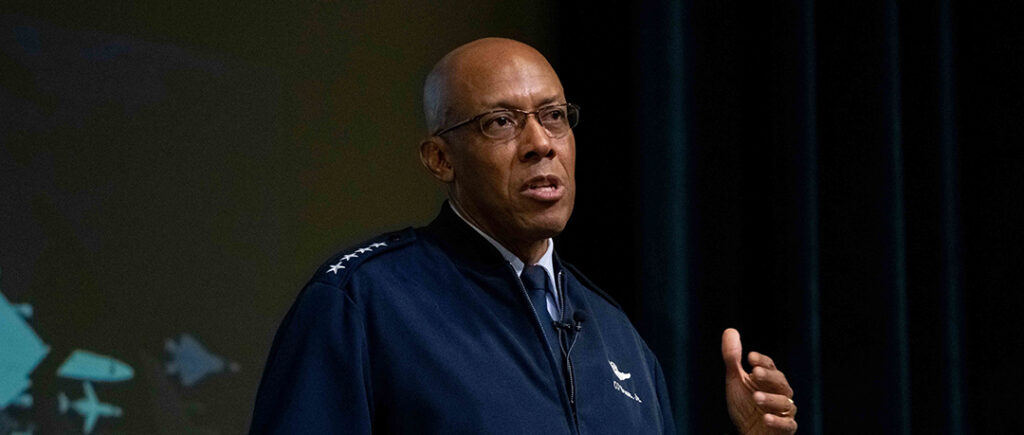THE WATCH STAFF
United States Air Force Chief of Staff Gen. Charles Q. Brown Jr. met with Royal Canadian Air Force (RCAF) leaders in Ottawa to further strengthen the long and unique relationship between the two countries.
During the June 8-9, 2022, visit, Brown, pictured, met with his RCAF counterpart, Lt. Gen. Al Meinzinger, and Maj. Gen. Sylvain Ménard, the chief of fighter capability, at National Defence Headquarters. Brown also took part in a wreath-laying ceremony at the National War Memorial in the Canadian capitol.
The RCAF leaders discussed the strategic importance of the Arctic as well as infrastructure and technology upgrades for the North American Aerospace Defense Command (NORAD). NORAD is the U.S. and Canadian binational organization charged with aerospace warning, aerospace control and maritime warning for North America.
“We are committed to working with the Royal Canadian Air Force on modernizing NORAD and on Arctic security to meet modern challenges in (continental) defense,” Brown said, according to a June 10 Air Force news release. “Our continued collaboration is helping better prepare us to meet future challenges in the region together. I’m grateful for our partnership and look forward to building on our productive talks.”
Brown’s visit to Ottawa coincided with one by Canadian Prime Minister Justin Trudeau to NORAD headquarters in Colorado Springs, Colorado, on June 7. Trudeau was joined by U.S. Secretary of Defense Lloyd J. Austin III and Canadian Minister of National Defence Anita Anand. During the prime minister’s visit, he took part in classified briefings and met with the U.S. Northern Command and NORAD commander, Air Force Gen. Glen D. VanHerck, and NORAD’s Canadian deputy commander, Lt. Gen. Alain Pelletier.
In November 2021, Austin and then-Canadian National Defence Minister Harjit Sajjan released a joint statement outlining priorities for modernizing NORAD, including “next-generation over-the-horizon radar systems that can dramatically improve early warning and persistent surveillance of North American airspace and approaches” to replace the aging North Warning System, Air Force Magazine reported June 13.
The Ottawa Citizen newspaper reported in April that RCAF leaders had briefed industry officials about plans to spend $1 billion on a radar system to be built in southern Canada with such capabilities.
As for the Arctic, the U.S. and Canada are frequent partners in joint exercises across air, land and maritime domains. The region has become more contested by strategic competitors Russia and the People’s Republic of China as melting ice opens sea lanes and access to natural resources.
Brown also welcomed Canada’s decision to buy the F-35, according to the news release. In March, the Canadian government announced plans to buy 88 of the advanced fighter jets.
However, the final contracts with manufacturer Lockheed Martin have not been signed, and according to Canada’s Global News, it is not guaranteed that a deal will be reached, Air Force Magazine reported.
Brown “noted that the increased capabilities and interoperability afforded by a common platform would bolster the continental defense partnership,” according to the USAF release. Should the deal be reached, Canada would join fellow U.S. allies Denmark, Finland and Norway as Arctic nations that either operate or have agreed to buy F-35s, according to Air Force Magazine.
IMAGE CREDIT: CASSANDRA CORNWELL/U.S. AIR FORCE

